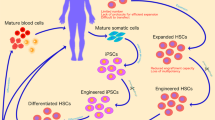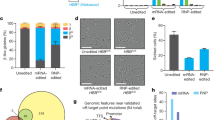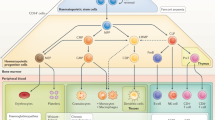Abstract
Gene therapy treatment of disease will be greatly facilitated by the identification of genetic mutations through the Human Genome Project. The specific treatment will ultimately depend on the type of mutation as different genetic lesions will require different gene therapies. For example, large rearrangements and translocations may call for complementation with vectors containing the cDNA for the wild-type (wt) gene. On the other hand, smaller lesions, such as the reversion, addition or deletion of only a few base pairs, on single genes, or monogenic disorders, lend themselves to gene targeting. The potential for one gene targeting technique, small fragment homologous replacement (SFHR) to the gene therapy treatment of sickle cell disease (SCD) is presented. Successful conversion of the wt-β-globin locus to a SCD genotype of human lymphocytes (K562) and progenitor/stem hematopoietic cells (CD34+ and lin-CD38−) was achieved by electroporation or microinjection small DNA fragments (SDF).
This is a preview of subscription content, access via your institution
Access options
Subscribe to this journal
Receive 12 print issues and online access
$259.00 per year
only $21.58 per issue
Buy this article
- Purchase on Springer Link
- Instant access to full article PDF
Prices may be subject to local taxes which are calculated during checkout



Similar content being viewed by others
References
Colosimo A et al. Targeted correction of a defective selectable marker gene in human epithelial cells by small DNA fragments Mol Ther 2001 3: 178–185
Thorpe P, Stevenson B, Gohil A, Porteous D . Towards CFTR gene correction: a comparison of two key strategies Ped Pulmon 2000 241
Kapsa R et al. In vivo and in vitro correction of the mdx dystrophin gene nonsense mutation by short-fragment homologous replacement Hum Gene Ther 2001 12: 629–642
Goncz K, Kunzelmann K, Xu Z, Gruenert D . Targeted replacement of normal and mutant CFTR sequences in human airway epithelial cells using DNA fragments Hum Mol Genet 1998 7: 1913–1919
Kunzelmann K et al. Gene targeting of CFTR DNA in CF epithelial cells Gene Therapy 1996 3: 859–867
Sangiuolo F et al. In vitro correction of CF cells using SFHR technique Pediatric Pulmonary 2000 240
Goncz K et al. Expression of DeltaF508 CFTR in normal mouse lung after site-specific modification of CFTR sequences by SFHR Gene Therapy 2001 8: 961–965
Goncz K . Conversion of normal β-globin to sickle β-globin by small fragment homologous replacement Blood 2000 96: 379b
Mookerjee B, Arcasoy M, Atweh G . Spontaneous delta- to beta-globin switching in K562 human leukemia cells Blood 1992 79: 820–825
Mahajan M, Weissman S . DNA-dependent adenosine triphosphatase (helicase-like transcription factor) activates beta-globin transcription in K562 cells Blood 2002 99: 348–356
Goncz K, Gruenert D . Progress toward nucleotide sequence modification at the genome level: small fragment homologous replacement Biotechnology 2001 3: 113–120
Xiang Y et al. Targeted gene conversion in a mammalian CD34+ enriched cell population using chimeric RNA/DNA oligonucleotides J Mol Med 1997 75: 829–835
Holmes A et al. Intracellular compartmentalization of DNA fragments in cultured airway epithelial cells mediated by cationic lipids Pharm Res 1999 16: 1020–1025
Kasahara N, Dozy A, Kan YW . Tissue-specific targeting of retroviral vectors through ligand-receptor interactions Science 1994 266: 1373–1376
Takekoshi KJ et al. Retroviral transfer of a human beta-globin/delta-globin hybrid gene linked to beta locus control region hypersensitive site 2 aimed at the gene therapy of sickle cell disease Proc Natl Acad Sci USA 1995 92: 3014–3018
Miyoshi H et al. Transduction of human CD34+ cells that mediate long-term engraftment of NOD/SCID mice by HIV vectors Science 1999 283: 682–686
Naldini L, Verma IM . Lentiviral vectors Adv Virus Res 2000 55: 599–609
Hirata R, Miller A, Andrews R, Russell D . Transduction of hematopoietic cells by foamy virus vectors Blood 1996 88: 3654–3661
Einerhand MP et al. Regulated high-level human beta-globin gene expression in erythroid cells following recombinant adeno-associated virus-mediated gene transfer Gene Therapy 1995 2: 336–343
Lubovy M et al. Stable transduction of recombinant adeno-associated virus into hematopoietic stem cells from normal and sickle cell patients Biol Blood Marrow Transplant 1996 2: 24–30
Fritsch G et al. The composition of CD34 subpopulations differs between marrow, blood and cord blood Bone Marrow Transplant 1996 17: 169–178
Wang J, Doedens M, Dick J . Primitive human hematopoietic cells are enriched in cord blood compared with adult bone marrow or mobilized peripheral blood as measured by the quantitative in vivo SCID-repopulating cell assay Blood 1997 89: 3919–3924
Colosimo A et al. Simple version of ‘megaprimer’ PCR for site-directed mutagenesis BioTechniques 1999 26: 870–873
Davis B et al. Glass needle-mediated microinjection of macromolecules and transgenes into primary human blood stem/progenitor cells Blood 2000 95: 437–444
Author information
Authors and Affiliations
Rights and permissions
About this article
Cite this article
Goncz, K., Prokopishyn, N., Chow, B. et al. Application of SFHR to gene therapy of monogenic disorders. Gene Ther 9, 691–694 (2002). https://doi.org/10.1038/sj.gt.3301743
Published:
Issue Date:
DOI: https://doi.org/10.1038/sj.gt.3301743
Keywords
This article is cited by
-
The Gene Targeting Approach of Small Fragment Homologous Replacement (SFHR) Alters the Expression Patterns of DNA Repair and Cell Cycle Control Genes
Molecular Therapy - Nucleic Acids (2016)
-
Use of genome-editing tools to treat sickle cell disease
Human Genetics (2016)
-
Multiple copies of a linear donor fragment released in situ from a vector improve the efficiency of zinc-finger nuclease-mediated genome editing
Gene Therapy (2014)
-
Systemic delivery of triplex-forming PNA and donor DNA by nanoparticles mediates site-specific genome editing of human hematopoietic cells in vivo
Gene Therapy (2013)
-
Nanoparticles Deliver Triplex-forming PNAs for Site-specific Genomic Recombination in CD34+ Human Hematopoietic Progenitors
Molecular Therapy (2011)



